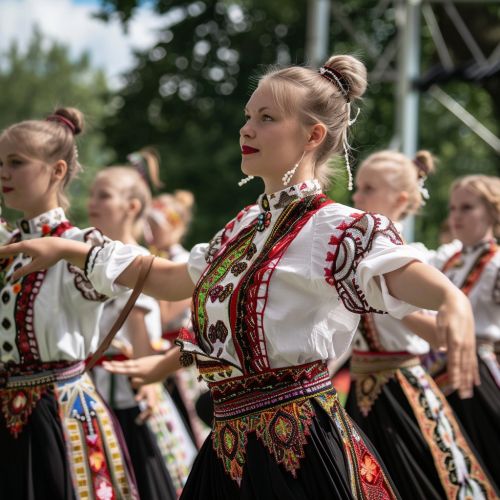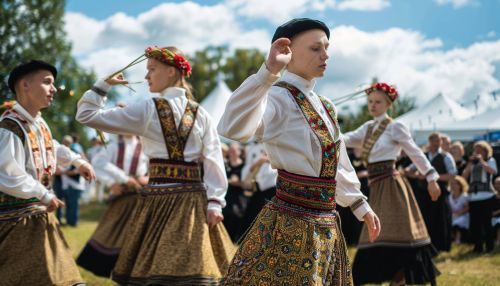Estonian music
History of Estonian Music
The history of Estonian music is a rich tapestry that spans centuries, reflecting the nation's cultural evolution and its interactions with neighboring regions. Estonian music has been shaped by various influences, including the indigenous Finnic traditions, the impact of the Baltic Germans, and the broader European classical music traditions.
Early Music
The earliest forms of music in Estonia were primarily folk music, which played a crucial role in the daily lives of the Estonian people. These traditional songs, known as regilaul, are characterized by their unique runo-song structure, which features a repetitive and alliterative verse form. Regilaul songs were often performed during various rituals, such as weddings, funerals, and seasonal festivals.


Medieval and Renaissance Period
During the medieval period, Estonia was influenced by the Teutonic Order and the Hanseatic League, which brought with them new musical styles and instruments. The introduction of the church organ and the establishment of church choirs marked a significant development in Estonian music. The Renaissance period saw the emergence of polyphonic choral music, which was performed in both religious and secular contexts.
Baroque and Classical Period
The Baroque period in Estonia was marked by the influence of the Baltic German nobility, who were patrons of the arts. Composers such as Johann Valentin Meder and Johann Christoph Friedrich Bach were active in Estonia during this time, contributing to the development of a local Baroque music tradition. The Classical period saw the establishment of the first public concerts and the formation of musical societies, which played a crucial role in promoting classical music in Estonia.
19th Century National Awakening
The 19th century was a period of national awakening for Estonia, and music played a central role in this cultural renaissance. The Estonian Song Festival, first held in 1869, became a symbol of national identity and unity. Composers such as Miina Härma and Rudolf Tobias emerged during this time, creating works that drew on both folk traditions and European classical music.
20th Century and Modern Era
The 20th century brought significant changes to Estonian music, with the country experiencing periods of independence, occupation, and eventual restoration of independence in 1991. These historical events had a profound impact on the development of Estonian music.
Early 20th Century
The early 20th century saw the rise of prominent composers such as Heino Eller and Eduard Tubin, who were instrumental in establishing a distinctive Estonian classical music tradition. The Estonian National Opera was founded in 1906, providing a platform for the performance of both local and international works.
Soviet Occupation
During the Soviet occupation (1940-1991), Estonian music faced significant challenges, with strict censorship and control over artistic expression. However, composers such as Arvo Pärt and Veljo Tormis managed to create innovative works that subtly resisted Soviet ideology. Pärt's development of the tintinnabuli style and Tormis's use of traditional folk motifs are notable examples of this period.
Post-Independence Era
Since regaining independence in 1991, Estonia has experienced a vibrant musical renaissance. The Estonian Philharmonic Chamber Choir and the Tallinn Chamber Orchestra have gained international acclaim, and contemporary composers such as Erkki-Sven Tüür and Helena Tulve continue to push the boundaries of modern classical music.
Traditional Music
Traditional Estonian music is characterized by its use of unique instruments and distinctive musical forms. The kannel, a type of zither, is one of the most iconic traditional instruments. Other traditional instruments include the torupill (bagpipe) and the viiul (fiddle).
Regilaul
Regilaul, or runo-song, is a central element of traditional Estonian music. These songs are typically performed in a call-and-response format, with a lead singer and a chorus. The lyrics often deal with themes of nature, mythology, and daily life.
Instrumental Music
Instrumental music in Estonia has a long history, with traditional dance tunes such as the polka and the waltz being popular. The kannel is often used to accompany these dances, along with other instruments like the torupill and the viiul.
Choral Music
Choral music holds a special place in Estonian culture, with a strong tradition of both amateur and professional choirs. The Estonian Song Festival, held every five years, is one of the largest choral events in the world, attracting thousands of singers and spectators.
Estonian Song Festival
The Estonian Song Festival, or Laulupidu, is a major cultural event that celebrates the nation's choral tradition. The festival features performances by large choirs, often numbering in the tens of thousands, and includes both traditional folk songs and contemporary choral works.
Prominent Choirs
Estonia is home to several renowned choirs, including the Estonian National Male Choir and the Estonian Philharmonic Chamber Choir. These choirs have gained international recognition for their high level of artistry and their commitment to performing both Estonian and international repertoire.
Contemporary Music
Contemporary Estonian music is diverse, encompassing a wide range of genres and styles. From classical and jazz to electronic and pop, Estonian musicians continue to innovate and explore new musical horizons.
Classical and Contemporary Classical
Contemporary classical music in Estonia is marked by the works of composers such as Arvo Pärt, Erkki-Sven Tüür, and Helena Tulve. Pärt's minimalist style, known as tintinnabuli, has had a significant influence on contemporary classical music worldwide.
Jazz
Jazz has a strong presence in Estonia, with a vibrant scene that includes festivals, clubs, and educational programs. The Jazzkaar festival, held annually in Tallinn, is one of the most important jazz events in the region, attracting international artists and audiences.
Popular Music
Estonian popular music encompasses a wide range of genres, including rock, pop, and electronic music. Artists such as Kerli, Ewert and The Two Dragons, and NOËP have gained international recognition, contributing to the global visibility of Estonian music.
Music Education
Music education is highly valued in Estonia, with a strong emphasis on both formal and informal learning. The Estonian Academy of Music and Theatre is the leading institution for higher music education, offering programs in performance, composition, and musicology.
Early Music Education
Early music education in Estonia often begins in specialized music schools, where children receive training in various instruments and music theory. These schools play a crucial role in nurturing young talent and preparing students for advanced studies.
Higher Education
The Estonian Academy of Music and Theatre, founded in 1919, is the premier institution for higher music education in Estonia. The academy offers a wide range of programs, including performance, composition, conducting, and musicology. Many of Estonia's leading musicians and composers are alumni of the academy.
